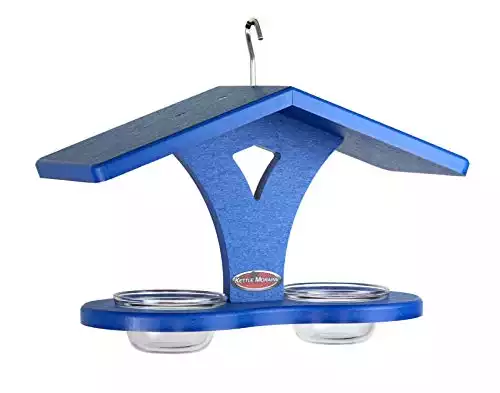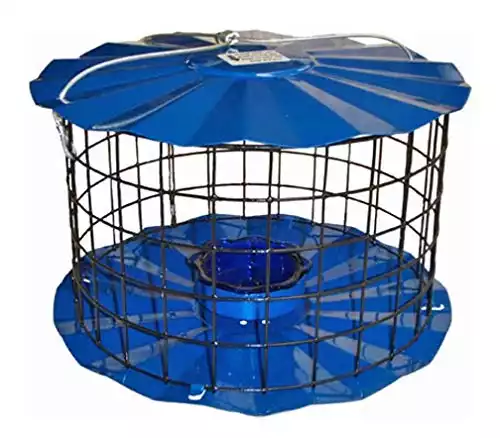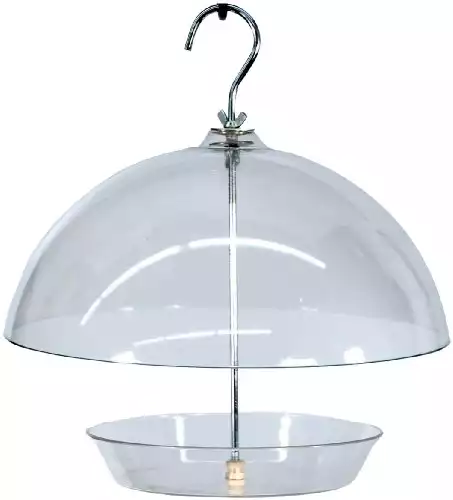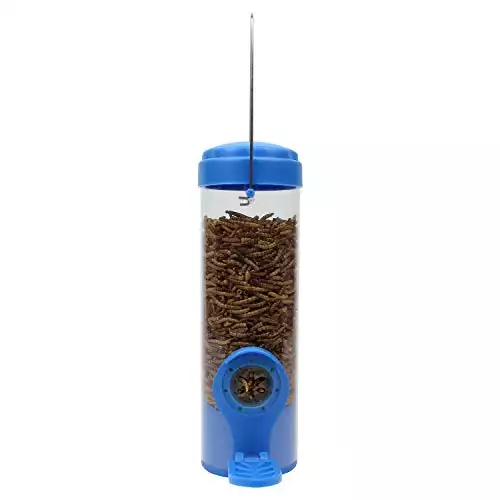The best bluebird feeder for your local songbird is a platform, jailed or hopper-style mealworm feeder. These feeders are specifically designed for smaller songbirds like bluebirds. Fill your feeder with mealworms, suet balls, and suet nuggets to attract bluebirds to your backyard!
North American bluebirds are a favorite of bird watchers. Bluebirds will visit birdf eeders that have good sources of protein such as mealworms, and suet. They are also attracted to sunflower seeds and some fruit.
There are three types of bluebirds you can attract, depending on the area:
- Eastern bluebirds – Dwell east of the Rocky Mountains
- Western bluebirds – Reside west of the Rocky Mountains
- Mountain bluebirds – Live in the Rocky Mountains
All three species are tiny songbirds with big personalities! Here, we will cover the best bluebird feeders and other ways you can attract bluebirds to your yard.
Bluebird Feeders Comparison Table
|
|
|
|
|
|
Pros:
|
Pros:
|
Pros:
|
Pros:
|
- Constructed using recycled materials
- Ample room for multiple birds to feed
- Two separate cups to offer different types of food
- The blue glass mealworm cup attracts bluebirds effectively
- Other small songbirds are attracted as well
- 30-day money-back guarantee
- Reputable brand
- Adjustable dome provides protection from rain and snow, keeps the bird food dry and fresh
- Spacious seed tray
- Flexports offer more feeding angles
- Gaps in the flexible cover are perfectly sized for dried mealworms
- Very easy to fill and clean
Our Top 4 Picks
1. Kettle Moraine Recycled Double Cup Platform Feeder
- Recycled materials
- Platform feeding area
- Easy to clean
- All-weather use
- Attractive design
The feeder is constructed using long-lasting recycled plastic lumber, which is made from recycled materials such as milk jugs. This eco-friendly material is durable and contributes to sustainability efforts.
It’s equipped with two separate cups, allowing you to offer different types of bird food simultaneously. This provides a variety of food options to attract bluebirds as well as other songbirds.
The overhanging roof ensures additional weather protection for the bird food and feeding area, keeping the seeds and mealworms dry during rain or snow.
It also features a large and sturdy open hook, making it easy to hang from a tree branch, a pole, or any other suitable location in your backyard.
Pros
- Users who value sustainability will likely appreciate the feeder’s construction using recycled materials
- The spacious platform provides ample room for multiple birds to feed together
- The inclusion of two separate cups allows users to offer different types of bird food simultaneously
Cons
- No issues reported by users
2. Erva Bluebird Feeder
- Versatile design
- Blue glass mealworm cup
- Squirrel and starling resistance
- Dishwasher-safe glass cup
- 30-day money-back guarantee
This is a versatile feeder designed to attract bluebirds and smaller fruit-eating birds like orioles, robins, cardinals, and catbirds.
The feeder attracts bluebirds thanks to the inclusion of a blue glass mealworm cup. Bluebirds are known to be attracted to the color blue, and mealworms are a favored food source for them.
The feeder is designed to be sturdy and durable, as well as resistant to squirrels and starlings, which can be problematic for some bird feeders.
The package includes the bluebird feeder, a quick release thumb nut for easy disassembly, and a removable blue glass mealworm dish.
The product comes with a 30-day money-back guarantee, allowing customers to return it if they are not satisfied, with no questions asked.
Pros
- Users appreciate the feeder’s design, including the blue glass mealworm cup, which is known to attract bluebirds effectively
- The feeder can attract other small fruit-eating birds in addition to bluebirds
- The 30-day money-back guarantee gives users confidence in trying out the product
Cons
- Accessing the mealworm cup is a bit challenging
- Expensive
3. Woodlink Audubon Dome Bluebird Feeder
- Heavy-duty polycarbonate construction
- All-weather feeding
- Large seed tray
- Adjustable dome
The Woodlink Audubon Dome bluebird feeder is designed to attract both seed-eating birds and bluebirds. The can accommodate a variety of bird species, including sparrows, finches, and chickadees, as well as bluebirds.
It’s made of heavy-duty polycarbonate material, ensuring durability and resistance to weather elements. The UV resistance helps prevent discoloration or damage from prolonged exposure to sunlight.
The feeder includes a dedicated mealworm tray and an adjustable dome on top. This dome can be raised or lowered, providing protection from larger birds and weather conditions.
With the adjustable dome and sturdy construction, the feeder is suitable for all-weather feeding, protecting the food from rain and other environmental factors.
Pros
- Woodlink Audubon is a reputable brand known for its bird feeders, and users may trust the product’s quality and performance
- The adjustable dome on the feeder provides protection from rain and snow, helping to keep the bird food dry and fresh
- The feeder has a spacious seed tray which allows for multiple birds to feed together
Cons
- Some users experienced issues with the feeder’s construction and durability
4. Perky-Pet Mealworm Bird Feeder with Flexports
- Flexports design
- Enclosed design
- Removable lid
- Good dried mealworm capacity
- No food clogging
The feeder is designed to attract insect-eating birds, including bluebirds, woodpeckers, and other species that enjoy dried mealworms as a food source.
The feeder is equipped with 2 “Flexports,”; this flexible port design enhances the bird-feeding experience by offering more feeding angles and better visibility for the birds while they are feeding. The design of the Flexports also helps prevent clogging, which can be a common issue with standard ports in some bird feeders.
The feeder’s enclosed design helps keep the dried mealworms fresh and dry, protecting them from rain and moisture.
The removable lid makes it easy to fill the feeder with dried mealworms and clean the interior. It can hold up to 3.5 ounces of dried mealworms, providing ample food for the visiting birds.
Pros
- Users appreciate the unique Flexports design, which offers more feeding angles than standard ports
- The gaps in the flexible cover are perfectly sized for dried mealworms
- The feeder’s removable lid makes it convenient for users to fill the feeder and clean the interior when needed
Cons
- The perches often flip up when it’s windy; this issue can be fixed by using rubber bands to keep perches in place
What Type of Feeder Is Best for Bluebirds?
The best bluebird feeders are hanging or pole-mounted mealworm feeders. Bluebirds love dry or live mealworms. Choosing the right bird feeder and bird food is an important part of attracting bluebirds.
If you choose the wrong bird feeder or offer bird seed instead of mealworms, you’ll end up attracting other backyard birds. If attracting bluebirds is your goal, the mealworm feeder is the way to go.
Most mealworm feeders look like small pans and occasionally have two plexiglass sides. This makes it easy for bluebirds to see that there are mealworms inside and gives you a clear view of the birds while they feed.
Watch our video for more details on how to attract bluebirds to your garden!
Where Is the Best Place to Put Bluebird Feeders?
Bluebird feeders should be hung or pole-mounted to prevent easy access by predators and scavengers. Pole-mounting can be a little more challenging, but it’s much easier to keep a squirrel or raccoon away from the bird food using a feeder pole.
Stainless steel feeder poles are the most durable. You can easily add a squirrel baffle for extra protection. If you must use a hanging bluebird feeder, avoid chains that will allow the feeder to sway. A rigid metal hanger will keep the feeder stable and still.
Mount the feeder at an appropriate height, ideally around 5 to 6 feet above the ground. This height allows bluebirds to approach comfortably while keeping them safe from ground-based predators.
Also, bluebird feeders should be placed a good distance from human homes and at least 100 feet away from bluebird houses. Bluebirds don’t like to eat near their nesting sites.
Do I Need to Use a Mealworm Feeder?
Since you can buy mealworm feeders specifically for bluebirds, it’s a good idea to use a mealworm feeder. Mealworm bird feeders are readily available online on Amazon and other retailers.
Bluebirds will also eat suet balls and suet nuggets. While mealworms are their favorite, suet balls and nuggets made for bluebirds often have mealworms mixed in them and provide additional fat with sunflower hearts.
Planting native plants will also provide food and shelter for bluebirds. Native plants support native insects, which comprise the bulk of the bluebird’s diet.
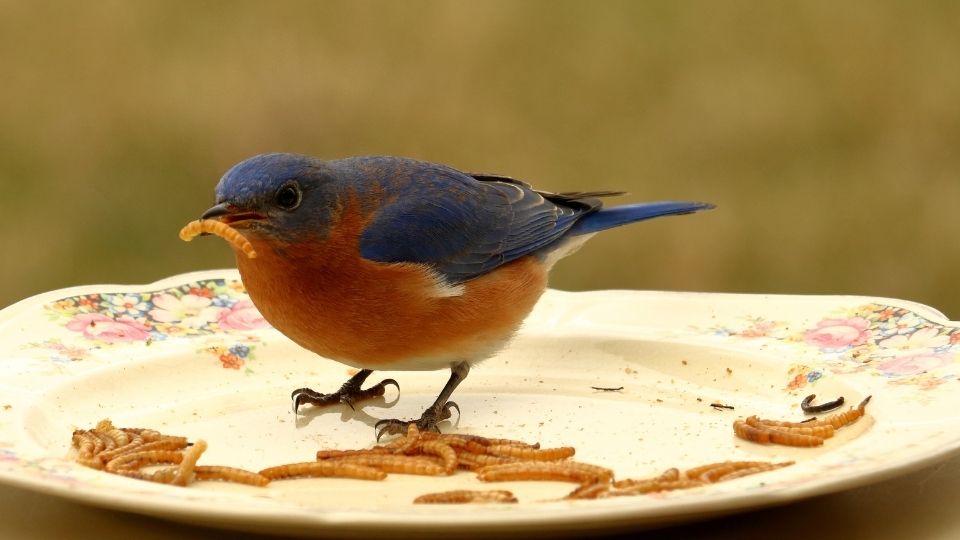
How do I Keep Starlings and House Sparrows Out of the Bluebird Feeder?
The best way to keep house sparrows and starlings from eating your bluebird food is to choose the right food and bird feeder.
House sparrows don’t eat mealworms, so they likely will not bother your bluebird feeder as long as it doesn’t have any other food mixed in with the mealworms. Starlings, on the other hand, love mealworms. You don’t want to attract either of these invasive birds.
Bluebird jail feeders–also known as caged feeders–are an excellent way to keep other wild birds out of your bluebird mealworm feeders. Many of these hanging bluebird feeders are also squirrel-proof!
Is a Window Bird Feeder Safe for Bluebirds?
Platform feeders attached to your window seem like a great way to watch bluebirds from the comfort of your home. Unfortunately, bluebirds are shy and are very unlikely to visit any feeder close to a house. Window feeders also make bird-window collisions more likely and are not safe.
Bird-window collisions account for up to one billion bird deaths each year in North America alone. Adding a bird feeder to your window can increase collisions.
In the video below, we discuss the meaning of crossing path with a Bluebird, whether in real life or your dreams.
Is it a Good Idea to Feed Wild Birds?
According to the Cornell Laboratory of Ornithology, feeding wild birds is important to conservation efforts.
As long as you provide the correct bird feed, feeding wild birds helps support them through habitat loss and other human-influenced consequences and hazards.
Quick Tips on How to Attract Bluebirds To Your Yard
Feeding bluebirds is a unique experience that makes backyard bird watching so much fun! There are many ways to attract these plucky little birds to your yard and keep them coming back year after year.
- Hang or pole mount mealworm feeders in your yard away from houses and nesting sites.
- Use squirrel-proof and house sparrow-resistant feeders.
- Jail or caged feeders are a great way to keep larger birds out of bluebird feeders.
- Provide separate feeders for birds like orioles, finches, and chickadees so more aggressive or larger birds won’t push out your bluebirds.
- Don’t forget bird baths and birdhouses for your bluebirds!
- Make sure bluebird houses and nest boxes are mounted using the Gilbertson pole mount system.
- Don’t use a perch for your bluebird houses or nest boxes. The Audubon and the Bluebird Society warn that perches help predators get into birdhouses.
- Clean up bird food daily to prevent predators.
- Plant or maintain native plants to support wild birds.


